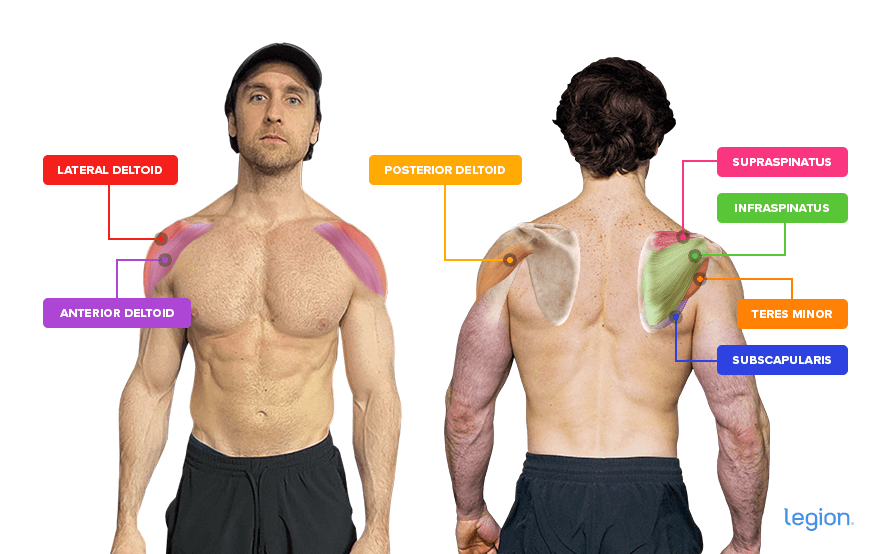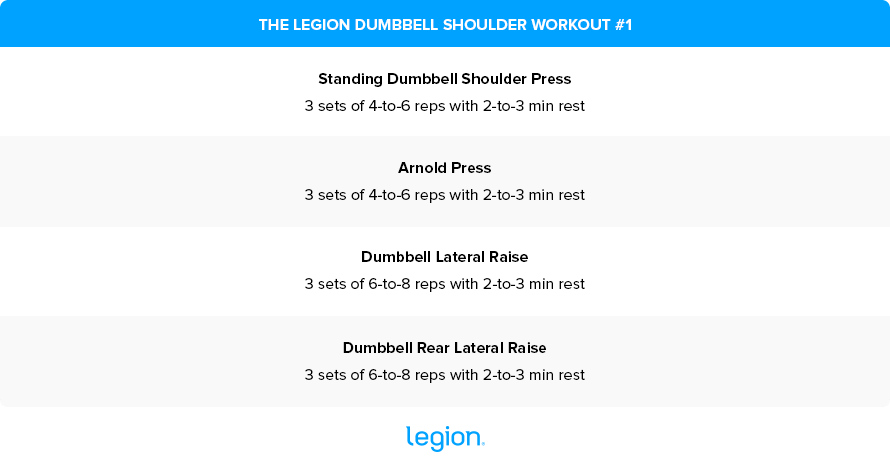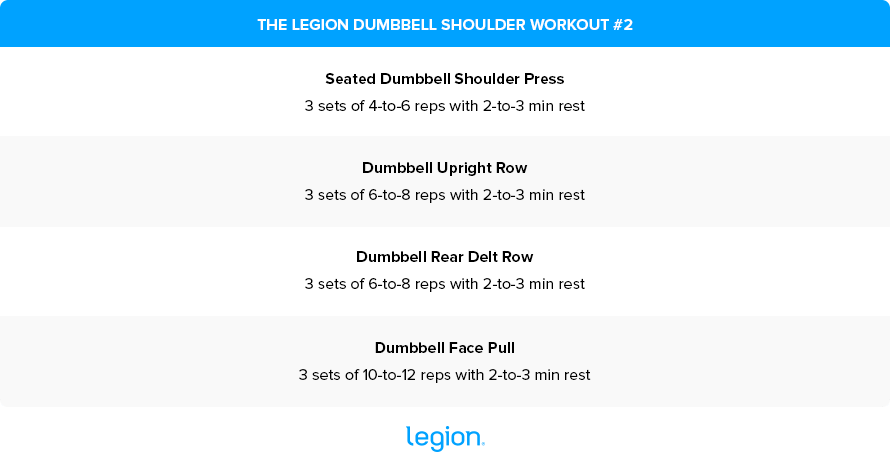Dumbbell shoulder workouts are excellent for building shoulder size and strength.
One of the key advantages of doing shoulder workouts with dumbbells is their versatility.
Dumbbells are highly maneuverable. As such, they allow you to effectively train every part of your complex shoulder muscles—something barbells and machines can’t match.
In this comprehensive guide to shoulder dumbbell workouts, you’ll learn the anatomy of the shoulders, the best exercises to train your shoulders with dumbbells, two evidence-based shoulder workouts with dumbbells for size and strength, and more.
Shoulder Anatomy
To create effective shoulder workouts with dumbbells, you need to understand the shoulder’s anatomy.
The deltoid muscles—or “delts”—cover your shoulder joints and allow your upper arms to move forward, upward, and backward.
Each deltoid has three sections or “heads:” the anterior deltoid (“front delt”), the lateral deltoid (“side delt”), and the posterior deltoid (“rear delt”).
Beneath the deltoids lies a complex network of muscles and tendons collectively known as the rotator cuff. This smaller yet vital muscle group functions with the deltoids to stabilize your shoulder joint and contribute to the shoulder’s remarkable range of motion.
The rotator cuff comprises the following four muscles and their tendons:
- Supraspinatus
- Infraspinatus
- Teres minor
- Subscapularis
Here’s how all these muscles look on your body:

Any good dumbbell shoulder workout should prioritize exercises that strengthen all three heads of the deltoids and the rotator cuff muscles. That way, you develop proportional shoulders that are stable and healthy.
The Best Exercises for a Dumbbell Shoulder Workout
Below are the best dumbbell shoulder exercises for training all three heads of your delts and rotator cuff muscles. Use these to create shoulder dumbbell workouts for all-around shoulder development.
1. Standing Dumbbell Shoulder Press
The standing dumbbell shoulder press trains all your shoulder muscles to a high degree and allows you to lift heavy weights safely and progress regularly, making it ideal for developing strong, proportional shoulders.
How to:
- Stand upright and hold a dumbbell in each hand.
- Hoist the dumbbells up so you’re holding them just above your shoulders with your palms facing away from you.
- Press the dumbbells toward the ceiling until your arms are straight.
- Lower the dumbbells and return to the starting position.
2. Seated Shoulder Press
The main benefit of the seated shoulder press is that it allows you to lift more weight than you can on standing overhead press variations, which is generally beneficial for muscle growth.
How to:
- Sit on an upright bench and hold a dumbbell in each hand, resting them on your thighs.
- Hoist the dumbbells up so you’re holding them just above your shoulders with your palms facing away from you.
- Press the dumbbells toward the ceiling until your arms are straight.
- Lower the dumbbells and return to the starting position.
3. Arnold Press
The Arnold press emphasizes your side delts more than other overhead pressing variations, making it an excellent shoulder dumbbell exercise for balanced shoulder development.
How to:
- Sit on an upright bench and hold a dumbbell in each hand, resting them on your thighs.
- Hoist the dumbbells up so you’re holding them just in front of your shoulders with your palms facing you.
- Press the dumbbells straight overhead while rotating your wrists until your arms are straight and your palms are facing away from you.
- Reverse the movement and return to the starting position.
4. Dumbbell Front Raise
The dumbbell front raise targets the front delts. While these muscles get plenty of stimulation during pressing dumbbell shoulder exercises, the front raise can be useful if you’re working around an injury and can’t perform presses.
How to:
- Stand up straight with a dumbbell in each hand.
- Raise the dumbbells out in front. Continue raising your arms until your upper arms are parallel to the floor.
- Reverse the movement and return to the starting position.
5. Dumbbell Lateral Raise
The dumbbell side raise is one of the best isolation exercises for the side delts. Developing the side delts is vital for developing the “capped” and broad look many want.
How to:
- Stand up straight with a dumbbell in each hand.
- Raise the dumbbells out to your sides until your upper arms are parallel to the floor.
- Reverse the movement and return to the starting position.
6. Dumbbell Upright Row
The dumbbell upright row trains your side delts similarly to the side raise, making it a top-tier dumbbell shoulder exercise for rounding out shoulder development. That said, some people find the upright row unkind on their rotator cuff muscles and shoulder joints. To avoid this, simply raise the weight until your upper arm is parallel to the floor and no further.
How to:
- Stand upright with a dumbbell in each hand.
- Hold the dumbbells in front of your thighs with your palms facing you.
- Lift the weights straight upward until they’re at chest height, keeping your elbows higher than your forearms throughout the movement.
- Reverse the movement and return to the starting position.
7. Dumbbell Rear Lateral Raise
As well as being an excellent dumbbell exercise for training your rear delts, the dumbbell rear lateral raise effectively trains the traps and upper back, which helps to give your upper body all-around thickness.
How to:
- Whether standing or seated, bend at the hips so that your upper body is as close to parallel to the floor as possible.
- Hold a dumbbell in each hand, and while keeping your back flat, lift the dumbbells out to the side until your upper arm is parallel to the floor. As you lift the dumbbells, squeeze your shoulder blades together.
- Reverse the movement and return to the starting position.
8. Dumbbell Rear Delt Row
The dumbbell rear delt row is similar to the dumbbell bent-over row except that you pull the weights to your mid-chest instead of your stomach. This reduces the amount your lats contribute to the exercise and makes it more taxing on your rear delts.
How to:
- While holding a dumbbell in each hand, position your feet shoulder-width apart with your toes pointed slightly outward.
- Bend over and flatten your back so it’s roughly parallel to the floor, and let your arms hang straight down.
- Pull the dumbbells to your mid-chest, flaring your elbows at about a 60-degree angle relative to your body.
- Reverse the movement and return to the starting position.
9. Dumbbell Face Pull
Face pulls strengthen the shoulder muscles responsible for pulling horizontally toward your face and rotating your arm upward, which is difficult to do with any other exercise and may improve shoulder health.
How to:
- While holding a dumbbell in each hand, stand with your feet shoulder-width apart with your toes pointed slightly outward.
- Bend over at the waist until your back forms a 45-degree angle with the floor, and allow your arms to hang straight down.
- Keeping your upper arms flared 90 degrees from your torso, pull the dumbbells upward and apart until they’re on either side of your face.
- Reverse the movement and return to the starting position.
The Best Shoulder Workouts with Dumbbells
The dumbbell shoulder workouts below contain all the best dumbbell shoulder exercises and the perfect mix of volume and intensity to help you gain shoulder size and strength.
To get the best results from these shoulder workouts with dumbbells, do Dumbbell Shoulder Workout #1 once weekly for 8-to-10 weeks, take a deload, then do Dumbbell Shoulder Workout #2 once weekly for the following 8-to-10 weeks.
From there, continue alternating between the workouts every 8-to-10 weeks of training, separating each “block” with a deload.
Dumbbell Shoulder Workout #1

Dumbbell Shoulder Workout #2

Dumbbell Shoulder Workout Tips
1. End every set 1-to-2 reps shy of muscle failure.
To maximize muscle and strength gains, you must take most of your sets within a rep or two of muscle failure.
Ask yourself at the end of each set, “If I had to, how many more reps could I have gotten with good form?” If the answer is more than two, increase the weight or reps to make your next set more challenging.
2. Once you hit the top of your rep range for one set, increase the weight.
If your shoulder dumbbell workout calls for 4-to-6 reps of the seated shoulder press and you get 6 reps for a set, use dumbbells that are 5 pounds heavier for the next set and continue as normal.
If you manage 3 or fewer reps with the new heavier weight, go back to using the lighter dumbbells until you can press them for 2 sets of 6 reps before trying the heavier dumbbells again.
If you still can’t press the heavier dumbbells for a set of 4 reps, work with the lighter dumbbells until you press them for 3 sets of 6 reps.
By that point, you should be able to lift the heavier dumbbells for at least 3 sets of 4 reps (the bottom of your target rep range).
Follow this pattern of trying to add reps or weight to every exercise in every workout.
3. Take the right supplements.
The best supplements for maximizing shoulder development are:
- Protein powder: Protein powder provides your body with the nutrients needed to build muscle tissue and recover from workouts. If you want a clean and delicious protein powder, try Whey+ or Casein+.
- Creatine: Creatine boosts muscle and strength gain, improves anaerobic endurance, and reduces muscle damage and soreness from your workouts. For a natural source of creatine that also includes two other ingredients to enhance muscle growth and improve recovery, try Recharge.
- Pre-workout: A high-quality pre-workout enhances energy, mood, and focus, increases strength and endurance, and reduces fatigue. For a top-tier pre-workout containing clinically effective doses of 6 science-backed ingredients, try Pulse with caffeine or without.
(If you’d like even more specific advice about which supplements you should take to reach your health and fitness goals, take the Legion Supplement Finder Quiz, and in less than a minute, you’ll know exactly what supplements are right for you. Click here to check it out.)
+ Scientific References
- Smita Maruvada, and Matthew Varacallo. “Anatomy, Rotator Cuff.” Nih.gov, StatPearls Publishing, 14 Nov. 2018, www.ncbi.nlm.nih.gov/books/NBK441844/.
- Saeterbakken, Atle H., and Marius S. Fimland. “Effects of Body Position and Loading Modality on Muscle Activity and Strength in Shoulder Presses.” Journal of Strength and Conditioning Research, vol. 27, no. 7, July 2013, pp. 1824–1831, https://doi.org/10.1519/jsc.0b013e318276b873.
- Raizada, Shiny , and Amritashish Bagchi. Comparison among the EMG Activity of the Anterior Deltoid and Medial Deltoid during Two Variations of Dumbbell Shoulder Press Exercise. Oct. 2017, https://doi.org/10.5958/0976-5506.2017.00411.9.
- Coratella, Giuseppe, et al. “An Electromyographic Analysis of Lateral Raise Variations and Frontal Raise in Competitive Bodybuilders.” International Journal of Environmental Research and Public Health, vol. 17, no. 17, 19 Aug. 2020, p. 6015, https://doi.org/10.3390/ijerph17176015.
- Campos, Yuri A. C., et al. “Different Shoulder Exercises Affect the Activation of Deltoid Portions in Resistance-Trained Individuals.” Journal of Human Kinetics, vol. 75, no. 1, 31 Oct. 2020, pp. 5–14, https://doi.org/10.2478/hukin-2020-0033.
- Kevin D. Sweeney, et al. “Impact of Shippers’ Choice on Transportation System Congestion and Performance”: Transportation Journal, vol. 53, no. 2, 2014, p. 143, https://doi.org/10.5325/transportationj.53.2.0143.
- Schoenfeld, Brad J , et al. The Upright Row: Implications for Preventing Subacromial Impingement. Oct. 2011, pp. 33(5):25-28, https://doi.org/10.1519/SSC.0b013e31822ec3e3.
- Jeno, Susan H, and Matthew Varacallo. “Anatomy, Back, Latissimus Dorsi.” Nih.gov, StatPearls Publishing, 5 Apr. 2019, www.ncbi.nlm.nih.gov/books/NBK448120/.
- Kolber, Morey J., et al. “Characteristics of Shoulder Impingement in the Recreational Weight-Training Population.” The Journal of Strength & Conditioning Research, vol. 28, no. 4, 1 Apr. 2014, pp. 1081–1089, journals.lww.com/nsca-jscr/FullText/2014/04000/Characteristics_of_Shoulder_Impingement_in_the.28.aspx, https://doi.org/10.1519/JSC.0000000000000250.
- Stokes, Tanner, et al. “Recent Perspectives Regarding the Role of Dietary Protein for the Promotion of Muscle Hypertrophy with Resistance Exercise Training.” Nutrients, vol. 10, no. 2, 7 Feb. 2018, p. 180, www.mdpi.com/2072-6643/10/2/180/pdf, https://doi.org/10.3390/nu10020180.
- Jd, Branch. “Effect of Creatine Supplementation on Body Composition and Performance: A Meta-Analysis.” International Journal of Sport Nutrition and Exercise Metabolism, 1 June 2003, pubmed.ncbi.nlm.nih.gov/12945830/.
- Eckerson, Joan M., et al. “Effect of Creatine Phosphate Supplementation on Anaerobic Working Capacity and Body Weight after Two and Six Days of Loading in Men and Women.” The Journal of Strength and Conditioning Research, vol. 19, no. 4, 2005, p. 756, https://doi.org/10.1519/r-16924.1.
- Bassit, Reinaldo Abunasser, et al. “Effect of Short-Term Creatine Supplementation on Markers of Skeletal Muscle Damage after Strenuous Contractile Activity.” European Journal of Applied Physiology, vol. 108, no. 5, 3 Dec. 2009, pp. 945–955, https://doi.org/10.1007/s00421-009-1305-1.









